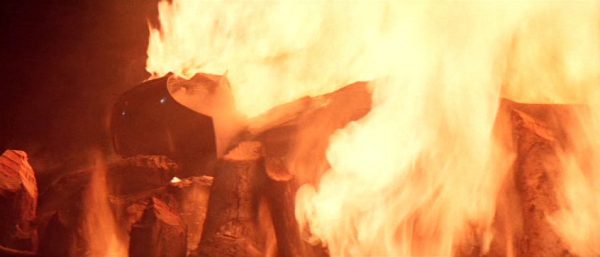‘An essay’s heat is interior’, writes Cynthia Ozick in ‘She: Portrait of the Essay as a Warm Body’. When I first came across Ozick’s piece in The Atlantic (later to serve as her introduction to the 1998 issue of the Best American Essays series), the title gave me great hope. This is the writer, after all, who famously asked Norman Mailer what colour ink he dips his balls in. Yes, the essay as a woman, the essay as a body, flesh and blood: vulnerable, resilient, proud, secretive, rebellious, surprising. ‘A warm body’ can mean a placeholder, a stand-in, filler, an innocuous form carefully placed to occupy space – a neutral, affable presence. But here, I thought, the warm body must be something else: an indentation left in the sheets, a fleeting form of hotness, words burned into the ether, a radiant, unapologetic scorch mark; but also with grim suggestions of the cadaver, as in, the body was still warm.
Ozick’s essay was in fact slightly more tepid than I had imagined. She was interested in the essay as the formal embodiment of a female protagonist who gives voice to the ‘sensations of the self’: ‘she is there, a living voice. She takes us in.’ Still, the idea of the essay as a potentially incendiary form has stayed with me, and something about Ozick’s proposal seems radical and exciting. It’s as if the essay is alive in a way that other forms are not; as if it possesses human traits and bodily characteristics, making it particularly supple and fitting when it comes to writing about certain conditions or experiences. What might this look like on the page? Two recent debut essay collections offer some interesting possibilities. ‘How much can a body endure? Almost everything,’ Chelsea Hodson asks and rejoinders in, Tonight I’m Someone Else. ‘Sometimes it seems that you don’t know your body at all. The names and locations of things. You need someone else to tell you what your body is doing,’ writes Ashleigh Young in Can You Tolerate This?. Though markedly different from each other in tone and temperament, these two books similarly inhabit the essay as a form that is protean and unpredictable, one that we might consider as inherently related to desire and longing, memory and loss, but also, or perhaps as such, to the physical body and its pains.
The title essay of Young’s collection finds her in a chiropractor’s office, marvelling at the small intimacies of her doctor’s ministrations, the calm that seems to radiate from his gentle manipulations of her body. ‘Can you tolerate this?’ he asks, as he presses into her spine. Young imagines the body as ‘first and foremost a structure like flat-pack furniture or a foldaway bed’, belying a belief in the body as studied, predictable, controlled. Beneath these surface assertions, however, Young is aware that the body is unruly and at times incapable of tolerating even the gentlest of pressures. In ‘Bones’, the skeletal system is exteriorised – literally and figuratively. The essay tells the story of Harry Raymond Eastlack, who suffered from fibrodysplasia ossificans progressiva, a rare tissue disease in which fibrous tissue – including muscle, tendon, ligament – is ossified when damaged, essentially turning to bone parts of the body that were previously elastic and fleshy, the body’s repair system gone awry. Young imagines, in evocative metaphors, Harry’s body in transition as it hardens and contorts, ‘he lay in bed at home, a diagram of himself, as if his second skeleton wanted to fuse him to a single spot and keep him safe there.’ His skeleton, today on display at the Mütter Museum of the College of Physicians in Philadelphia, stands as a ‘contained explosion’, the record of a body that is ‘forever breaking but never broken.’ The body has agency; the body endures.
The mutating, resilient body occurs in other essays, other iterations: the body that grows excessive hair; the transition from feral child, bodiless and free, to hyper-aware and weighted down, that pivotal shift; the adult who experiences her body with loathing, and turns to yogic ritual and routine in an attempt to escape it – to transform and transcend. Like Harry’s skeleton, which continues to stand resolutely and without support, Young shows how many ways we will bend but not break. And, moreover, that the ways we find to write about these transformative states of being might help us to make some sense of them; might develop a language that links images and experiences we have no other way of holding together.
In ‘Big Red’, Young recalls a tutor’s advice to ‘write yourself toward an understanding’, as she grapples with how to write an essay about her brother JP, which is also an essay about family, childhood, memory and the awkward, embarrassed awareness of having only half-understood events as they happened. It is also an essay about one’s place as an individual in the wider world, and how this might relate to the duties of a writer. How do you fix family members to the page in an honest way, and what is the relationship between memory and essayistic narrative? ‘I believed that simply describing these people, especially at those times when they were most mysterious to me, would show their faces to me more clearly and bring me closer to them.’
The collection’s longest essay, ‘Big Red’ is a paean to JP who, like Young herself, emerges as a character who is always on the outside of – but keenly observing – the mainstream. The essay moves back and forward in time, incorporating Young’s memories of JP, past and present, whose comically enormous red winter coat gives the essay its title. A series of JP’s own anecdotes are relayed in insightful detail, almost as if Young has lived through them herself. Young’s writing is not self-conscious, rather it subtly performs the twists and turns of an empathetic mind in recollection, using the essay to effectively foreground these interior machinations as a writerly concern.
Young’s essays are insightful and exquisitely sensitive. They capture what it’s like to occupy a particular time of life, as a young woman and writer, when childhood and adulthood seem to collapse into one another – yet both remain so fresh, familiar and uncanny. How to portray, never mind accept, parents as individuals; and how to do justice to the idea of ‘home’, the landscapes that shaped you, which have become deeply-rooted interior geographies of the self. Young’s remote New Zealand hometown, Te Kūiti, features frequently in Can You Tolerate This?. She describes her adolescent impression of ‘the hills, the row of pines above a clay bank… these surroundings confirmed and enhanced my loneliness, showed me that it was real.’ In Young’s writing there is as much joy as there is sorrow in having moved on from Te Kūiti, if only because she knows that it can never be returned to again in the same way. But of course, she can write about the bittersweet knowledge she has gained, and she does so with great poignancy.
If Young’s Can You Tolerate This? is a slow burn, offering essays that unfold carefully in language that is measured and nuanced, Hodson’s Tonight I’m Someone Else is suffused with hunger and desire, vulnerability and violence – all delivered with calm, bare-faced aplomb. These essays have a lot of space in them: Hodson’s writing embraces the fragment and the collage, splinters of stories and flashes of recollection assert themselves confidently, often without context or transitions. Which is not to say that they are structured randomly or without attention. There is a sense of drama, of carefully plotted rhythm and pace in Hodson’s writing, which employs a variety of effects: images, narrative anecdotes, memories, aphoristic maxims, extratextual references and performative statements that sometimes read like provocations. ‘Don’t you know you can’t trust a writer? She’ll see a cigarette and call it a house on fire. She’ll take a suggestion and turn it into a crime scene. She’ll wrap herself up in caution tape. She’ll write you down,’ Hodson writes in ‘The New Love’. And later in the same essay, ‘The new love is half human, half stage – we perform until we get it right. The new love is an incision where no one can see it, a bed folding into itself. The new love is a careless archive, just put it somewhere and hurry would you.’
This voice that wants to challenge or to confront roves through the essays, punctuating their more linear narratives with beguiling asides, and asking the reader to make connections in the blank spaces between fragments. Hodson’s essays defy easy resolution and finitude, avoiding a single interpretation in favour of the suggestive, as if we inhabit a state of mind, rather than a particular story. Indeed, as in so many good collections, it’s difficult to distil these essays into specific narratives or arguments. There are threads that repeat: the scorched landscape of Arizona; a tender but dangerous man named Cody; adolescent female friendships; Hodson’s part-time jobs working for the Phoenix Mars Mission, selling clothes, working at a copy shop where she is stalked by a male customer; luxury; money; loneliness; sexual desire; nihilistic flirtations with violence. But the essays are not about these things; they slip in and out, circle them in eddies, because the subject is really Hodson’s mind in motion, and what she discovers as she sifts through and arranges these fragments, and puts them into writing.
The yearning to be elsewhere is also a recurring feature. ‘I wanted the unknown, the other, the superior version of myself, and I still do,’ Hodson writes in ‘Leaving Me’. ‘I long and long – that word almost makes me love English again, makes me think I might be able to say what I mean.’ Hodson repeatedly returns to her desire to somehow leave the self and to access experiences that seem remote or impossible. Writing out of the self and into another state, another form of being, an almost numinous realm: ‘What’s the point of longing? To continue. What’s the end of longing? More longing.’ In her book On Longing, Susan Stewart writes of longing as a kind of force, an incarnation of desire without object or subject, and so itinerant, rapacious, insatiable. It is this sense of longing that is the succour of Hodson’s essays: the energy and fervour of the suspended and the liminal. As in Young’s essays, the act of writing can take you some of the way – a channel by which experiences are parsed, collide and transform – but, in Tonight I’m Someone Else, the pleasure is also in never arriving at a final destination; in existing in that heightened space which is always in between, just before, almost, nearly – and so, and on.
There is pleasure, too, in the unbecoming of the self – transformation, performance, the inhabiting of personae – not simply as a narrative act, but as a means to become a more expansive version of the self. Yes, of course, we contain multitudes; but there is the sense in Hodson’s essays that there is a version of this specific to women’s lives, the female body and self. One in which the opportunity to become someone else, tonight or any other night, is the most exciting way to harness that which seems otherwise prohibited and inaccessible. ‘A woman becomes a girl becomes an animal becomes an object,’ Hodson writes in ‘Pity the Animal’, the collection’s longest essay, which was also originally published as a chapbook. ‘So circle me like the prey I’m dressed as, erase my pencilled-in boundary, pay me for the privilege.’
Hodson presses against ideas of the human as animal, animal as human, to think about the female body and commodification, responsibility, ownership and agency. She works at American Apparel, where she is aware her body, slickly garbed in AA merchandise, is effectively part of what is on sale; she experiments with the idea of setting up a profile as an escort, exchanging messages with prospective clients whose solicitations reveal all the different projections a woman can host; she thinks constantly of Marina Abramovic and her ongoing performance at the Museum of Modern Art, in the summer of 2010, sitting for eight hours a day while individual visitors are invited to sit across from her in a kind of silent communion.
In between these passages, which jump around chronologically, Hodson weaves in references from Selling Services with Goods, a 1921 book about construction window displays, Joseph Delmont’s 1931 book, Catching Wild Beasts Alive (the title speaks for itself), and a disturbing passage from an instructional YouTube video called ‘GTA [Grand Theft Auto’ 5 Take a Stripper home, Have Sex with a Stripper (BOOBS) GTA V’. These quotations jarringly evoke competing versions of how to buy and sell, hunt and capture, pursue, exchange, possess. Hodson skilfully weaves together a disparate but specific constellation of contents and contexts to fashion an essay that tilts and shifts, slithers and refuses to stay still. In Tonight I’m Someone Else, each essay is a possibility, a place to refashion and to question the self, to test the limits of the body, and sometimes the heart.
In The Body in Pain, Elaine Scarry writes of physical pain as unlike other states of consciousness, in that it has no referential content, resists objectification in language – ‘it is not of or for anything’ – and this is what makes it so powerful and devastating. The body in pain, she says, works through similes or metaphors – the pain is ABC, the hurt is like XYZ – in order to ‘make sharable what is originally an interior and unshareable experience.’ Can You Tolerate This? and Tonight I’m Someone Else are not essay collections about bodies in pain, although they may feature them, and Scarry’s project is ultimately more political, and yet – alongside Ozick’s warm body, the essay of interior heat – I kept returning to this idea: how to make sharable the wordless, that which does not have a corresponding object? Desire, pain, memory, loss, longing, yearning; that endless urge for more and new and different. Maybe this is a desperate question, but can a form be a solution? Write your way through to an understanding, as Young’s teacher told her. Or maybe just write your way through, because understanding might be on the other side and the essay that emerges may be helpful – incendiary, resplendent – nonetheless. Can You Tolerate This? and Tonight I’m Someone Else do away with straightforward answers in favour of giving shape, sensation, structure and voice to so much more: they are there, living voices. They take us in.




